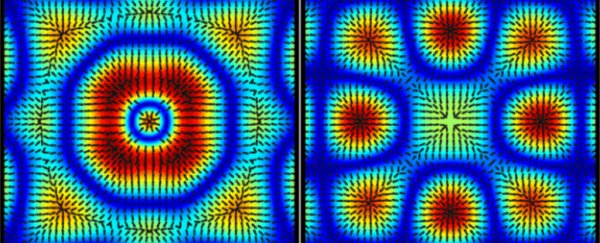In 1787, the "father of acoustics" Ernst Chladni first recorded the pattern of behaviour of sand grains on a vibrating plate – the way that heavier particles travel away from the vibrations, and lighter particles move towards them. In a new experiment underwater, researchers have now observed the exact opposite happening.
This latest study could fundamentally change our thinking about how sound can move particles through vibrations – views that have been in place for over 200 years. Further, it might also open up new methods for manipulating particles in industry and medicine.
Scientists from Aalto University in Finland found that when a plate is vibrated underwater, the heavier particles head for the spots where the amplitude of motion is the greatest, known as the antinodes. The term they're using for the strange effect is "inverse Chladni patterns".
 Heavy particles move towards antinodes of a submerged vibrating plate (Latifi et al., Physical Review Letters, 2019)
Heavy particles move towards antinodes of a submerged vibrating plate (Latifi et al., Physical Review Letters, 2019)
"This is a surprising result, almost a contradiction to common beliefs," says one of the researchers, Quan Zhou.
For the experiment, Zhou and his colleagues used glass beads less than a millimetre (0.04 inches) in size, spread over a submerged silicon plate on a piezoelectric transducer. The plate was then vibrated at a variety of frequencies, creating waves on the water.
So why was the effect the opposite of what was expected?
It was early 19th century scientist Michael Faraday who explained the original effect Chladni saw, suggesting that heavy particles get kicked across the plate until they reach the nodal lines, the points of least vibration. When this happens, they're no longer getting kicked with the same force.
 Particles manipulated to separate into groups (Latifi et al., Physical Review Letters, 2019)
Particles manipulated to separate into groups (Latifi et al., Physical Review Letters, 2019)
The researchers behind the new experiment think that the presence of the waves in the water, the pressure of gravity, and fluid drag act against the natural push for the particles to jump up from the plate's surface.
Using this knowledge, the team behind the experiment developed computer algorithms that could adjust the frequency of the plate vibrations in order to control the direction of the glass beads – essentially plotting a course for particles in real time.
"We can move particles at almost any frequency, and we do not rely on the resonance of the plate," says Zhou. "This gives us a lot of freedom in motion control."
For example, the researchers successfully guided a single particle through a maze, and also merged and separated a swarm of particles by playing different musical notes.
 Particle manipulated to navigate through a maze (Latifi et al., Physical Review Letters, 2019)
Particle manipulated to navigate through a maze (Latifi et al., Physical Review Letters, 2019)
If the technique can be successfully scaled down, there are a lot of areas in biological and medical applications where this could come in handy – any kind of situation where tiny objects (maybe even living cells) need to be directed towards a target.
"Many procedures in pharmaceutical research and microsystem assembly require the ability to move and manipulate small particles easily," says Zhou.
"Using just a single actuator to do all these different things, we are opening a path to new particle handling techniques. Additionally, the method can inspire the future factory-on-a-chip systems."
The research has been published in Physical Review Letters.
